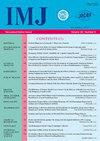SONOGRAPHIC MARKERS OF ASSOCIATION OF FOLATE CYCLE POLYMORPHIC GENES AND EPIGENETIC FACTORS
Q4 Medicine
引用次数: 0
Abstract
Reproductive losses in Ukraine are about twice the European average, but have the same causes: miscarriage, abortion, malformations, parental infertility, death of women of childbearing age and children under six days of age. The study focuses on genetically determined reproductive losses associated with folate cycle polymorphism, some other polymorphisms, and epigenetic factors that increase the risk of adverse pregnancy outcomes. Methods of systematic and demographic analysis studied the indices of medical and statistical observation of the population of the Kharkiv region within the period of 2008−2018 with an emphasis on the results of biochemical, molecular genetic and sonographic examinations of pregnant women. Data on the number of examined pregnant women were analyzed using ultrasonographic and biochemical studies at the level of alpha−fetoprotein, chorionic gonadotropin and free estriol in the framework of selective screening programs for pregnant women. Statistical data on the number of fetuses and newborns who died during the first − sixth day after birth, with a distribution on the basis of full−term have been studied. The data are compared with similar national indices. The directions of reducing the reproductive losses are offered, including complex inspection of pregnant women with use of ultrasonography, biochemical and molecular−genetic methods of diagnostics of genetic diseases and defects of fetus development. Among the epigenetic factors we have identified obesity and old age of pregnant women, among the types of abortions we did medical abortions associated with stillborn pregnancies, as well as miscarriages. The findings of the study can be used to minimize the effects of risk factors for reproductive loss in the activity of general practitioners. Key words: polymorphism of folate cycle genes, reproductive losses, miscarriage, congenital malformations of fetus, ultrasonography.叶酸周期多态性基因与表观遗传因子关联的超声标记
乌克兰的生殖损失大约是欧洲平均水平的两倍,但原因相同:流产、流产、畸形、父母不育、育龄妇女和6天以下儿童死亡。该研究的重点是与叶酸周期多态性、其他一些多态性和表观遗传因素相关的遗传决定的生殖损失,这些因素会增加不良妊娠结局的风险。系统和人口统计学分析方法研究了哈尔科夫地区2008 - 2018年期间人口的医学和统计观察指标,重点是孕妇的生化、分子遗传学和超声检查结果。在孕妇选择性筛查计划的框架内,采用超声检查和生化检查对检查的孕妇数量进行分析,检测α -胎儿蛋白、绒毛膜促性腺激素和游离雌三醇的水平。对出生后第1天至第6天死亡的胎儿和新生儿数量的统计数据进行了研究,并以足月为基础进行了分布。这些数据与类似的国家指数进行了比较。提出了减少生殖损失的方向,包括利用超声检查对孕妇进行综合检查,利用生物化学和分子遗传学方法诊断遗传疾病和胎儿发育缺陷。在表观遗传因素中,我们已经确定了孕妇的肥胖和老年,在流产类型中,我们进行了与死胎妊娠和流产相关的药物流产。研究结果可用于将全科医生活动中生殖丧失风险因素的影响降至最低。关键词:叶酸周期基因多态性,生殖丧失,流产,胎儿先天性畸形,超声检查。
本文章由计算机程序翻译,如有差异,请以英文原文为准。
求助全文
约1分钟内获得全文
求助全文
来源期刊

International Medical Journal
医学-医学:内科
自引率
0.00%
发文量
21
审稿时长
4-8 weeks
期刊介绍:
The International Medical Journal is intended to provide a multidisciplinary forum for the exchange of ideas and information among professionals concerned with medicine and related disciplines in the world. It is recognized that many other disciplines have an important contribution to make in furthering knowledge of the physical life and mental life and the Editors welcome relevant contributions from them.
The Editors and Publishers wish to encourage a dialogue among the experts from different countries whose diverse cultures afford interesting and challenging alternatives to existing theories and practices. Priority will therefore be given to articles which are oriented to an international perspective. The journal will publish reviews of high quality on contemporary issues, significant clinical studies, and conceptual contributions, as well as serve in the rapid dissemination of important and relevant research findings.
The International Medical Journal (IMJ) was first established in 1994.
 求助内容:
求助内容: 应助结果提醒方式:
应助结果提醒方式:


